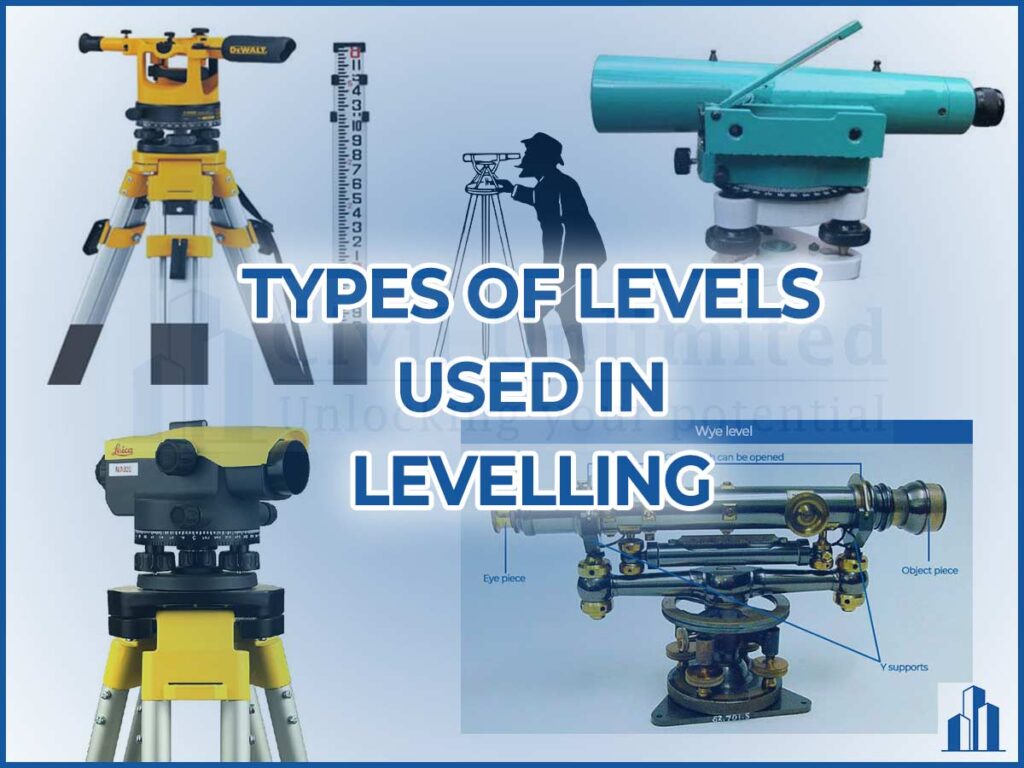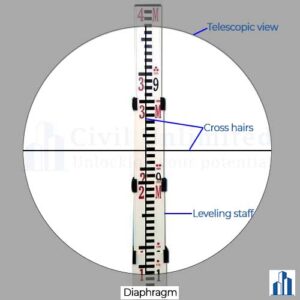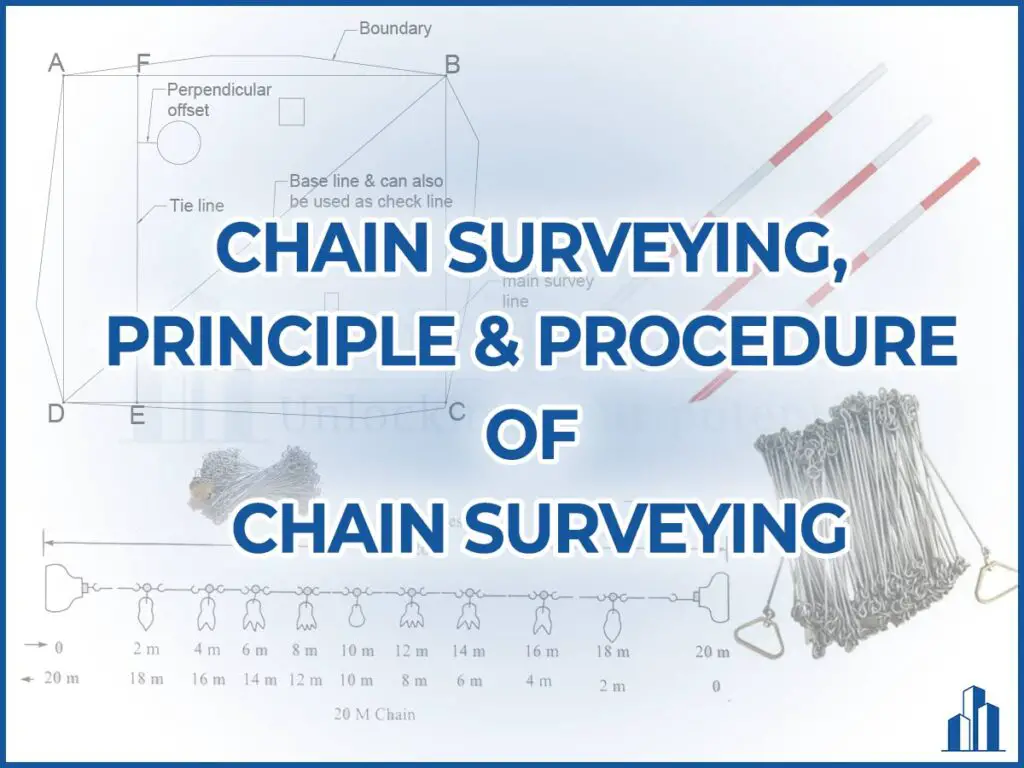There are two main instruments used in the levelling process. They are a level and a levelling staff. Let’s learn about levels in detail.
What is a level?
A level is an instrument which is used to create a horizontal line of sight for observing staff readings. Commonly, a level consists of the following parts,
- A telescope to provide the line of sight
- A level tube to make the line of sight exact horizontal
- A levelling head (a tri-screw arrangement which is used to center the level tube bubble)
- A tripod to support the instrument.
Types of levels
The types of levels commonly used are,
- Dumpy level
- Wye level
- Tilting level
- Transit level
- Auto level etc.
Let’s learn about each of them in detail.
1)Dumpy level
The dumpy level is a simple instrument which mainly consists of a telescope, a level tube, and a Levelling head. It can be fitted with a tripod.
The telescope is rigidly fixed to its supports, hence the telescope cannot be rotated on the vertical plane.

Now let’s learn about the components at the dumpy level.
a) Telescope
The telescope is an integral part of the dumpy level and it is placed in a spindle in such a way that it can be rotated along the horizontal axis. The important parts of a telescope are,
- Eyepiece – The eyepiece is present near the observer’s end and it is used by the observer to find the required target.
- Objective lens – Objective lens are provided on the opposite side of the eyepiece. It is also called the first lens. It forms a real image within the focal length of the eyepiece lens. Then the eyepiece forms a virtual image which can be observed by the observer.
- Diaphragm – The diaphragm is a dark cross wire which is exactly perpendicular to each other and provided in front of the eyepiece. These crosshairs are used by the eye to bisect the reading on the levelling staff.
b) Level tube – These tubes are used to check the level of the instrument. There are two tubes placed perpendicular to each other. When the bubbles are at the center, the instrument is said to be levelled accurately.
c) Levelling head – It consists of two triangular plates connected by 3-foot screws. The lower plate is connected to the tripod. The upper plate is known as tribrach and the lower plate is also known as trivet.
Advantages of using a dumpy level
- Simple to use with fewer moving parts
- Can be easily set up on any ground
- Only Fewer adjustments required
- The price of dumpy level is cheap compared to other instruments
2) Wye level
This instrument is somewhat similar to the dumpy level. The only difference here is the telescope is not fixed to the instrument instead it is supported by two vertical “Wye” or “ Y “ supports. This instrument is also known as Y level.
The Y supports consist of curved clips which can be opened and if needed, the telescope may be raised, removed, and rotated end to end.

Advantages of using a Wye level
- As both face readings can be taken easily, some of the errors are eliminated.
- The adjustment to the telescope can be done easily with greater speed. However, the adjustments do not have a longer life since they were too many moving parts.
3) Tilting level
In the case of dumpy level and wye level, Once the instrument is set up, the line of sight is exactly horizontal and perpendicular to the vertical axis. But this takes some time to level both the bubble tubes.
To eliminate this inconvenience, the tilting level is designed in such a way that the telescope can be tilted about four degrees with the help of tilting screws. Hence the bubble can be easily centered.
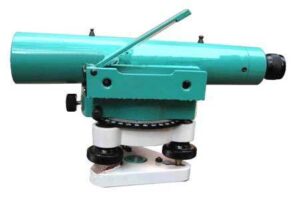
Advantages of using a tilting level
- Mainly used for precise levelling work
- The instrument can be levelled quickly but it needs centering of the bubble before taking every reading. Hence it is useful when readings from one instrument setting are few.
4) Transit level
A transit level is an optical instrument fitted with a telescope, spirit level, and mounted on a tripod. It is one of the best levels commonly used in surveying.
This instrument can be used to establish and transfer horizontal benchmarks with higher accuracy. It can also be used to measure distances, angles, and coordinates.
It is also known as Builder’s transit level.

Advantages of using a transit level
- The transit level telescope offers clear optics and stadia lines, hence it is easy to measure readings.
- It has a high magnifying capacity hence able to work easily in a longer range.
- This instrument offers high precision which yields highly accurate results.
5) Auto level
The auto-level or automatic level is a self-aligning level device.
Within a certain range of tilting, the instrument is automatically levelled itself by a device fitted inside called Inclination compensating device. Since it automatically levels itself to a certain degree, it lowers the work of the user to level the instrument and the levelling process can be completed quickly. Otherwise, it is also having the same components as other instruments.
It is the most widely used instrument nowadays because of its,
- Operational comfort
- High speed
- Precision
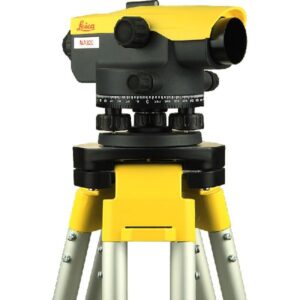
Hope this article gives you a brief outline about the levels used in the levelling process and if you have any queries leave it in the comment section.
Also read : Levelling in surveying – A brief outline
